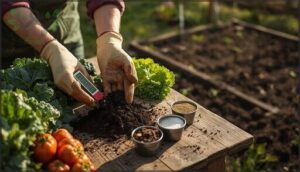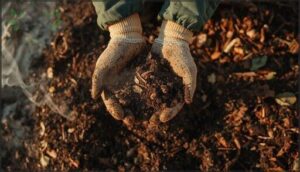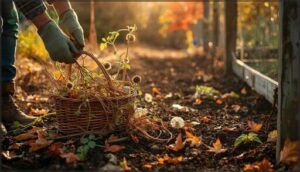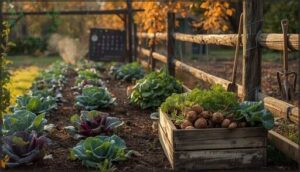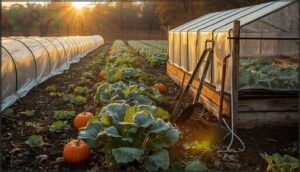This site is supported by our readers. We may earn a commission, at no cost to you, if you purchase through links.
Late August arrives, and while most gardeners watch their tomatoes ripen, you’re standing at a crossroads. Summer’s winding down, but your growing season doesn’t have to. Fall garden planning for cool weather opens a second chapter that many gardeners overlook, one where Brussels sprouts sweeten after the first frost and kale laughs off temperatures that would devastate summer crops.
The soil still holds warmth, the pest pressure drops, and suddenly you’ve got a window of opportunity that won’t wait. Smart planning now means you’ll harvest fresh greens well into winter, but timing matters more than you might expect—plant too early and seedlings struggle in summer’s lingering heat, too late and roots won’t establish before hard freezes arrive.
Table Of Contents
Key Takeaways
- Fall garden planning requires working backward from your first frost date, adding each crop’s days to maturity plus 14 extra days to account for slower growth in cooler temperatures.
- Root vegetables like carrots and beets undergo cold-sweetening when temperatures drop near 41°F, as their starches convert into protective sugars that noticeably improve flavor over 2–4 weeks following the first light freeze.
- Crop rotation with cool-season vegetables boosts yields by 10–25% compared to monocultures while reducing fertilizer needs, thanks to enhanced nutrient cycling and natural pest suppression.
- Apply 2–4 inches of organic mulch like straw or shredded leaves after soil cools but before hard freeze to reduce evaporation by 20–50% and moderate daily temperature swings that stress root systems.
Preparing Your Garden Beds for Fall
Getting your garden beds ready for fall isn’t just about clearing out old plants—it’s about creating the right foundation for cool-season success. The shift from summer to fall gardening requires some thoughtful soil work, cleanup, and preparation to help your crops thrive in cooler temperatures.
Here’s what you need to focus on to set up your beds for a productive fall harvest.
Soil Testing and Amending for Cool Weather Crops
Before you plant cool-season crops, testing your soil every one to two years helps you understand nutrient levels and pH. Most vegetables thrive when pH stays between 6.0 and 7.0, where nitrogen, phosphorus, and other nutrients work best. Cool conditions slow nutrient release, so knowing what your soil needs now prevents deficiencies later and guides smart amendment strategies for healthier garden beds.
Soil testing determines levels of phosphorus and potassium, so it’s key for understanding your soil’s composition and health, and helps identify deficiencies.
Incorporating Compost and Organic Fertilizers
Once you know what your soil needs, working in compost and organic fertilizers builds soil health and sets up your cool-season crops for success.
Well-matured compost generally delivers 0.5–2% nitrogen, plus phosphorus and potassium, while improving water holding capacity—sometimes up to 2.5 times in sandy soils. This organic gardening approach boosts soil structure, retains moisture during dry spells, and fosters stronger root growth through fall’s cooler weeks.
Using compost can greatly reduce irrigation requirements by improving water infiltration.
Removing Summer Debris and Weeds
After enriching your soil, the next step in fall garden planning is clearing out spent plants and weeds. Globally, weed competition cuts yields by 34% when left unchecked, so integrated sanitation matters. Remove debris within 24–48 hours after rain for easier root extraction, and time your cleanup before October to target overwintering pests.
This soil preparation balances garden maintenance with ecological trade-offs—pull diseased stems, but leave some clean stalks for beneficial insects.
Mulching for Moisture Retention and Temperature Control
Once you’ve cleared debris, a well-chosen mulch layer becomes your soil’s insulating blanket. Research shows organic mulches reduce evaporation by 20–50%, while moderating daily temperature swings that stress roots. For fall vegetable gardens, apply 2–4 inches of straw or shredded leaves to lock in moisture and buffer against early frosts—your cool-season crops will reward you with steadier growth and sweeter harvests.
- Choose coarser materials like wood chips or straw for better water retention and temperature regulation in your fall garden.
- Apply mulch after soil cools but before hard freeze to trap warmth and winter moisture around root zones.
- Refresh decomposing layers regularly, as finer mulches lose 25–50% of their depth each season, reducing their protective benefits.
Choosing The Best Cool-Season Vegetables
Choosing the right vegetables for your fall garden makes all the difference between a thriving harvest and disappointment. You’ll want to focus on varieties that actually enjoy cooler temperatures, rather than just tolerate them.
Let’s look at the specific crops that will turn your fall garden into a productive, flavorful success.
Top Cold-hardy Vegetable Varieties for Fall
For cold-hardy vegetables in your fall garden, kale and collards top the list—varieties like Siberian kale tolerate temperatures down to 10°F, while Brussels sprouts survive near 0°F and actually taste sweeter after frost.
For vegetable variety selection, consider cabbage, which manages mid-20s temperatures beautifully, and hardy beets and turnips that develop better flavor following light frosts.
Fast-growing Greens for Quick Harvests
For quick harvests, fast-growing leafy greens like arugula, lettuce, and spinach deliver baby leaves in just 20–30 days. Arugula provides excellent nutrient density with 90% of your daily vitamin K per 100 grams, while spinach offers even more.
Many varieties tolerate light frost and support multiple cuttings through fall, with regrowth yield maintaining continuous production when you succession-plant every few weeks.
Root Vegetables That Sweeten After Frost
Among the sweetest rewards of a fall vegetable garden, root vegetables like carrots and beets transform after exposure to frost. Cold-sweetening occurs when temperatures near 41°F trigger starch conversion into sugars that protect plant tissues, noticeably improving flavor over 2–4 weeks following the first light freeze.
Root vegetables like carrots and beets sweeten after frost as cold triggers their starches to convert into protective sugars
- Plant carrots and beets in late summer, 60–90 days before your first expected frost
- Make certain roots reach full size before sustained cold exposure begins
- Leave them in the ground through several light frosts for maximum sweetness
- Harvest before hard freezes below 27°F to avoid tissue damage
- Mulch heavily to buffer temperature swings and extend harvest quality
Selecting Overwintering Crops Like Garlic
Garlic stands apart among overwintering crops because it actually needs winter’s chill to form proper bulbs.
In zones 3–5, plant hardneck varieties like Porcelain types in late September at 2–4 inches deep, while softneck garlic suits zones 7–9 with late October planting.
Apply 4–6 inches of straw mulch after planting to protect cloves through freeze–thaw cycles and guarantee the vernalization your fall garden requires.
Timing and Planting Strategies
Getting your fall crops in the ground at the right time can make all the difference between a thriving harvest and a disappointing one. You’ll need to think backward from your first frost date, plan for multiple plantings, and consider how your crops fit into a healthy rotation.
Let’s break down the timing strategies that will help you boost your fall garden’s potential.
Calculating Planting Dates for Fall Harvest
Timing your fall vegetable garden right means working backward from your first frost date. Use regional calculators to count back from that frost date, adding each crop’s days to maturity plus a maturity fall factor—usually 14 extra days—to account for slower growth in cooler weather.
This planting schedule approach helps you match hardiness categories with your planting calendar, ensuring crops mature before temperatures drop too low.
Succession Planting for Continuous Yields
Instead of planting your entire fall vegetable garden at once, succession planting keeps harvests rolling in week after week. Stagger sowings every 7 to 14 days for crops like lettuce, radishes, and spinach—this approach, backed by West Virginia University Extension, maximizes garden space and extends your growing season without overwhelming you.
Key planting intervals for continuous yields:
- Fast greens like baby lettuce and cilantro: sow every 7 days for weekly harvests
- Root vegetables such as beets and turnips: plant every 14 days to manage maturity dates
- Carrots: space sowings 21 days apart, accounting for regional factors and slower fall growth
Crop Rotation for Soil Health
Beyond timing your plantings, crop rotation builds long-term soil health by cycling nutrients and boosting microbial diversity. Rotating heavy feeders like brassicas with nitrogen-fixing legumes cuts fertilizer needs while improving soil structure.
Research shows rotated crops yield 10–25% more than monocultures, thanks to pest suppression and enhanced nutrient cycling.
Plan multi-year rotations now to set your fall beds up for lasting productivity.
Regional Considerations for Fall Planting
While rotation sets the foundation, your growing zone and local microclimate shape what you can plant and when. Frost date variations across regions create planting windows that differ by more than two months—coastal advantages and urban heat islands can delay frost by weeks, while elevation effects drop temperatures faster.
Check zone 6A‑specific guides and monitor your backyard’s temperature patterns to match crops to your climate.
Protecting Fall Crops From Cold and Pests
As fall temperatures drop and pests look for one last meal before winter, your crops need a little extra care to keep producing. The good news is that protecting your garden doesn’t require fancy equipment or a big budget.
Let’s look at three practical strategies that’ll shield your plants from cold snaps and hungry insects.
Using Row Covers and Cold Frames Effectively
When frost threatens your fall crops, row covers and cold frames become your most reliable allies for extending the growing season. Lightweight cover materials raise temperatures by 2–8°F while offering pest exclusion—just secure edges tightly after planting.
Cold frames act as miniature greenhouses, protecting hardy greens well into winter. Choose heavier fabrics for better frost protection and temperature regulation, though expect replacement after 1–3 seasons.
Mulching Techniques for Insulation
After setting up row covers, turn your attention to mulch for deeper freeze-thaw protection. A 2–4 inch layer of organic material like straw or shredded leaves moderates soil temperature swings by up to 36°F, boosting overwintering survival dramatically.
Apply it once temperatures consistently drop below 20°F—too early keeps soil warm and delays plant hardening, weakening your crops’ cold tolerance.
Managing Common Fall Pests and Diseases
Despite cooler weather, aphids, cabbage loopers, and flea beetles stay active under fall’s moist conditions, while fungal diseases thrive when humidity climbs above 96%. Combine weekly scouting with targeted pest management for effective disease prevention:
- Row covers block moths from laying eggs on young brassicas
- Bacillus thuringiensis stops soft-bodied caterpillars without harming beneficials
- Neem oil controls aphid infestations before populations explode
- Sanitation—removing crop residues—cuts overwintering pest survival dramatically
Harvesting, Preserving, and Preparing for Spring
The final chapter of fall gardening brings your hard work full circle, from knowing when to harvest each vegetable to keeping your bounty fresh through winter.
You’ll also want to think about how to prepare your beds for the quieter months and what you can plant early next spring.
Here’s how to finish the season strong and set yourself up for success in the year ahead.
Best Practices for Harvesting Fall Vegetables
Best harvest time for your fall vegetable garden arrives early in the morning, when leaves are fully hydrated and temperatures remain cool. This simple timing choice preserves quality and flavor, since cold-hardy greens like kale and spinach lose nutrients rapidly in warm conditions.
When harvesting fall vegetables, always inspect your fall vegetable harvest for signs of contamination or damage, then handle produce gently to maintain freshness during post-harvest handling.
Storing and Preserving Your Fall Bounty
Once you’ve finished harvesting fall vegetables, you can lock in freshness using several proven methods:
- Root cellaring extends storage for carrots, beets, and parsnips up to six months at 32 to 36°F and near 100% humidity.
- Refrigeration lifespan for leafy greens reaches two to four weeks under proper conditions.
- Freezing vegetables preserves nutrients comparably to fresh produce.
- Fermentation methods and canning safety guidelines guarantee year-round access to your edible harvest.
Maintaining Garden Beds Through Winter
Winter mulching acts like a protective blanket, locking in soil health while you rest. Spread 3 to 6 inches of organic mulch over your beds to prevent erosion and maintain moisture.
Top prepared garden beds with 1 to 2 inches of compost for slow-release nutrients.
Consider planting cover crops to boost soil biology, suppress weeds, and improve structure through the dormant months.
Planning Early Spring Crops After Fall Gardening
Your fall garden feeds directly into spring success when you plan ahead for winter. Overwintering crops like garlic integration and hardy greens set the stage for early harvests, while succession strategies make sure beds turn over quickly:
- Plant garlic in October for June scapes and July bulbs
- Seed spinach by early September for extended spring yields
- Map bed turnover to follow overwintered plantings with peas
- Use season extension structures to accelerate early spring crops
- Schedule succession planting at 10- to 21-day intervals
These overwintering benefits compound when preparing for winter meets smart early spring planning.
Frequently Asked Questions (FAQs)
How do I water fall gardens differently than summer?
Water less often—cooler weather slows evaporation, so your fall garden needs far fewer deep drinks.
Morning irrigation prevents disease, and you’ll adjust volume based on rainfall, crop-specific needs, and temperature regulation for best soil health.
Can I plant cover crops between fall vegetables?
You can, but competition concerns make timing and species selection critical.
Plant slow-growing covers like crimson clover after vegetables are established, using wide spacing to minimize resource competition and support soil health.
What tools work best for fall garden maintenance?
For bed cleanup, you’ll need hand pruners, loppers, and garden forks. Stiff rakes efficiently gather debris, while wheelbarrows are ideal for transporting compost.
Rental tillers are recommended for larger plots. To extend the life of your tools, maintain them through sharpening.
How does fall gardening affect pollinators and beneficial insects?
Your late-season choices shape what lives and thrives. Leaving asters, goldenrod, and leaf litter offers nectar, refuge, and overwintering sites for bees, beetles, and beneficial insects that stabilize next year’s pest management naturally.
Should I adjust fertilizer ratios for fall versus spring?
Yes, your fall NPK ratios should shift toward lower nitrogen and higher potassium compared with spring.
Cool-season vegetables need less nitrogen as growth slows, reducing leaching risks while supporting root strength and cold tolerance.
Conclusion
Most gardeners think the growing season ends when summer does, yet that’s precisely when fall garden planning for cool weather becomes your secret advantage. While neighbors store their tools, you’re cultivating crops that actually prefer the chill.
You’ve learned the timing, chosen frost-loving varieties, and prepared beds that’ll keep producing when others’ gardens sit empty. That first bite of November kale, sweeter than anything July offered, proves summer never had the monopoly on fresh harvests.
- https://piedmontmastergardeners.org/article/planning-the-fall-vegetable-garden/
- https://www.pubs.ext.vt.edu/content/dam/pubs_ext_vt_edu/426/426-334/426-334_pdf.pdf
- https://awaytogarden.com/what-to-plant-now-for-a-fall-vegetable-garden/
- https://extension.umd.edu/resource/vegetable-planting-calendar
- https://wayne.ces.ncsu.edu/2025/08/time-to-plant-a-fall-vegetable-garden/


